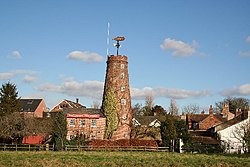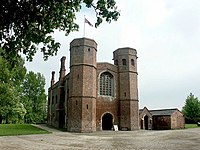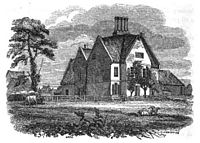Wainfleet All Saints
| Wainfleet All Saints | |
| Lincolnshire | |
|---|---|
 Salem Bridge Mill, Wainfleet | |
| Location | |
| Grid reference: | TF498591 |
| Location: | 53°6’28"N, -0°14’14"E |
| Data | |
| Population: | 1,964 |
| Post town: | Skegness |
| Postcode: | PE24 |
| Dialling code: | 01754 |
| Local Government | |
| Council: | East Lindsey |
| Parliamentary constituency: |
Boston and Skegness |
Wainfleet All Saints is an ancient port and market town on the east coast of Lincolnshire, on the A52 road 5 miles southwest of Skegness and 14 miles northeast of Boston. It stands on the small rivers Steeping and Limb that form Wainfleet Haven.
The town is close to the Lincolnshire Wolds. The village of Wainfleet St Mary is directly to the south.
History and landmarks

The name "Wainfleet" is the Old English Wægn fleot; "wagon stream".[1] The town stands on or near the former Roman settlement of Vainono. Two tumuli, one to the north and one to the south of the town, are of unknown origin, although it has been suggested that they could be Viking or Roman.[2] A number of coins from the period have been found in the vicinity. In the Domesday Book, Wainfleet is listed as Wenflet.[3]
The parish church of All Saints was built in 1820-21 following the demolition of a previous mediæval church of the same dedication, using part of the old church's material. A further church, St Thomas, had been destroyed by this time. During the demolition of All Saints the tomb of William of Waynflete's father, Richard Patten, was broken up but was later restored within Waynflete's Magdalen College Chapel, Oxford.
Waynflete founded the town's Magdalen College School in 1484,[3] and obtained for the town a charter of incorporation in 1457.
In 1847 Barkham Street, a 'London-style' terrace was commissioned by Bethlem Hospital and built to the design of Sydney Smirke and to similar specifications as other Bethlem terraces in Southwark, Surrey.
The Market Place has two Grade II listed structures, a clock tower erected in 1899,[4] and a 15th-century limestone Buttercross (set on three steps and topped with a 19th-century finial and weathervane), from which John Wesley preached.[5][6]
The town is notable for Batemans Brewery; the brewery building incorporates the Georgian Salem House[7] and a previous corn mill, Salem Bridge Mill.[6][8] Public houses in Wainfleet are the Woolpack Hotel, Royal Oak, and the Red Lion on High Street.
Skegness Grammar School has a boarding house in the town on Low Road.
Wainfleet became a conservation area in 1972.[6]
Northolme

At the northern end of Wainfleet All Saints is the hamlet of Northolme, which is all that remains of the lost parish of Wainfleet St Thomas.[9]
No distinction was made between Wainfleet All Saints, Wainfleet St Mary, or Wainfleet St Thomas, until a deed from Peter De Beningword to Bardney Abbey mentions North Wenfled. The original deed held in the British museum is undated, but is estimated to be from the 13th century.[10][11]
In 1316 Wainfleet St Thomas is mentioned as paying tax under Feudal Aid.[11] At the time of the reformation, the chapel belonged to Kyme Priory. There is no clear indication of when it was demolished, but it was still standing at the time of the Protectorate, when the general Baptists were granted its use.[9] Nothing remains of the chapel today, although its site is used as an extension of the present cemetery.[11]
In 1546 Thomas Lyttlebury Esq was heir to the manor of Northolme through his brother John. However it seems that the estate became the property of John's daughter, Alice, who married Thomas Upton. Thomas Upton's successors lived at Northolme Hall.[10]
The first Northolme Hall was an Elizabethan moated manor house, reputedly built in 1549. The present Northolme Hall was built on the same site in 1866.[12]
Outside links
| ("Wikimedia Commons" has material about Wainfleet All Saints) |
- Information on Wainfleet All Saints from GENUKI
- Wainfleet Group of Parishes- Church of England
- Town web site
- Wainfleet & District Motorcycle Club
References
- ↑ McAvoy, F.; Marine Salt Extraction:The Excavation of Salterns at Wainfleet St Mary, Lincolnshire ; p. 138; Archaeology Data Service; retrieved 30 April 2011
- ↑ "Wainfleet Conservation Area". Wainfleet Conservation Area. p. 8. http://www.e-lindsey.gov.uk/NR/rdonlyres/4B57C659-1C66-468E-AD15-A02203C2A8AA/0/wainfleet_conservation_area_appraisal.pdf. Retrieved 30 April 2011.
- ↑ 3.0 3.1 "The Magdalen College School, Wainfleet, Lincolnshire" BBC - The Guide to Life, The Universe and Everything.; retrieved 28 April 2011
- ↑ "Clock Tower, Wainfleet All Saints". British Listed Buildings. http://www.britishlistedbuildings.co.uk/en-420233-clock-tower-wainfleet-all-saints. Retrieved 28 April 2011.
- ↑ Wainfleet All Saints Lincolnshire Parish Councils; retrieved 30 April 2011
- ↑ 6.0 6.1 6.2 Wainfleet Conservation Area Appraisal East Lindsey District Council; retrieved 30 April 2011
- ↑ "George Bateman and Son: Lincolnshire's last brewery" Brewery History (online journal); retrieved 30 April 2011
- ↑ "Wainfleet All Saints windmill" Windmill World; retrieved 30 April 2011
- ↑ 9.0 9.1 History of Lincolnshire from the earliest period to the present time: Saunders, J (1836)
- ↑ 10.0 10.1 A Topographical and historical account of Wainfleet and the wapentake of Candleshoe in the county of Lincoln, page=81
- ↑ 11.0 11.1 11.2 National Monuments Record: No. 355157 – Northolme
- ↑ National Monuments Record: No. 355829 – Northolme Hall
